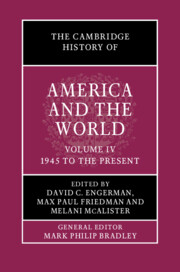Book contents
- The Cambridge History of America and the World
- The Cambridge History of America and the World
- The Cambridge History of America and the World
- Copyright page
- Contents
- Figures
- Maps
- Contributors to Volume IV
- General Introduction: What is America and the World?
- Introduction to Volume IV
- Part I Ordering a World of States
- 1 Global Capitalist Infrastructure and US Power
- 2 Overseas Bases and the Expansion of US Military Presence
- 3 The Consolidation of the Nuclear Age
- 4 American Knowledge of the World
- 5 The American Construction of the Communist Threat
- 6 The Fractured World of the Cold War
- 7 The US and the United Nations System
- 8 American Development Aid, Decolonization, and the Cold War
- 9 Decolonization and US Intervention in Asia
- Part II Challenging a World of States
- Part III New World Disorder?
- Index
7 - The US and the United Nations System
from Part I - Ordering a World of States
Published online by Cambridge University Press: 12 November 2021
- The Cambridge History of America and the World
- The Cambridge History of America and the World
- The Cambridge History of America and the World
- Copyright page
- Contents
- Figures
- Maps
- Contributors to Volume IV
- General Introduction: What is America and the World?
- Introduction to Volume IV
- Part I Ordering a World of States
- 1 Global Capitalist Infrastructure and US Power
- 2 Overseas Bases and the Expansion of US Military Presence
- 3 The Consolidation of the Nuclear Age
- 4 American Knowledge of the World
- 5 The American Construction of the Communist Threat
- 6 The Fractured World of the Cold War
- 7 The US and the United Nations System
- 8 American Development Aid, Decolonization, and the Cold War
- 9 Decolonization and US Intervention in Asia
- Part II Challenging a World of States
- Part III New World Disorder?
- Index
Summary
In the aftermath of World War II, the United States almost singlehandedly created the web of international institutions and organizations that comprise what is often referred to as the “liberal world order.” In the economic realm, American policymakers, working most closely with the British, designed what would become the International Monetary Fund and the World Bank. On trade matters, the United States considered plans for an International Trade Organization, although it ultimately designed and backed the less ambitious General Agreement on Trade and Tariffs. These efforts put in place international regimes and organizations that remain consequential today. But by far the highest-level American attention was reserved for the United Nations (UN), a new global organization designed to ensure future world peace and security.
- Type
- Chapter
- Information
- The Cambridge History of America and the World , pp. 172 - 189Publisher: Cambridge University PressPrint publication year: 2022

